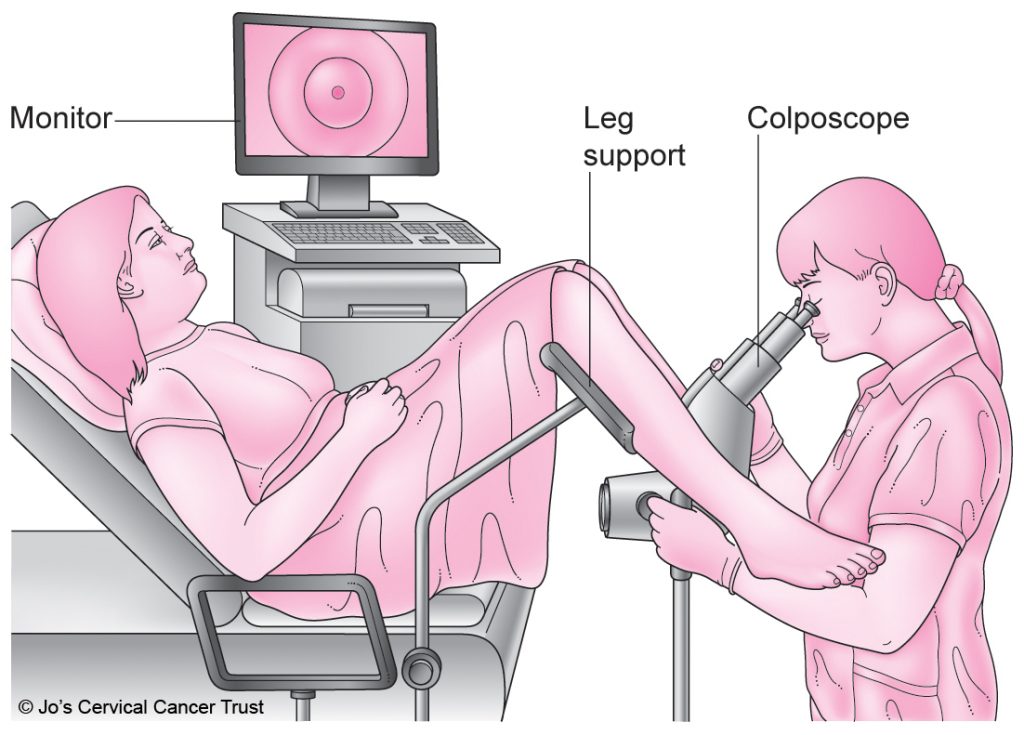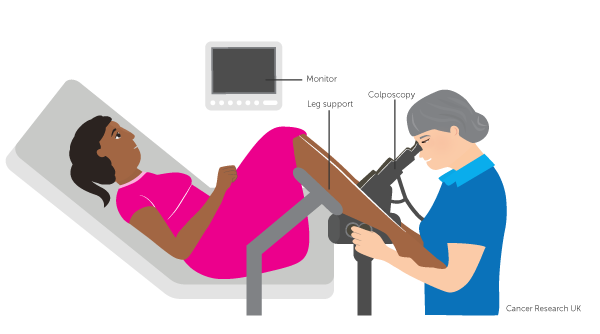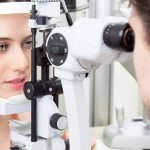
A colposcopy is a test to look at the cervix in detail. A colposcope is a large magnifying glass that a doctor or specialist nurse (a colposcopist) uses to look closely at the skin-like covering of the cervix. By looking through it, the colposcopist can see changes that may be too small to see with the naked eye. They can take samples (biopsies) of any abnormal areas.
You usually have a colposcopy in the hospital outpatient clinic.
Why you might have a colposcopy
You have a colposcopy if you’ve had an abnormal result after a cervical screening test.

You may also have a colposcopy if you have symptoms that could be due to cancer. This could be symptoms of:
- cervical cancer
- vaginal cancer
- vulval cancer
Preparing for a colposcopy
- Eat and drink as normal before your appointment.
- You may have sex in the time leading up to your appointment unless you have a coil fitted.
- If you have your period on the day of the appointment, contact the colposcopy clinic before your appointment.
- Bring a list of your medications to your appointment and let the colposcopist know about your medical history or any allergies.
- Make a note of when you had your last period.
- Remove any jewellery below the waist, such as a belly button or vaginal piercing at home. If you need treatment during the procedure, you will be asked to remove this.
- You may have some vaginal discharge after the examination. You will be provided with a sanitary towel, but bring your own if you prefer.
- You can bring someone with you in case you’re not feeling well after the appointment.
- Most people can drive home afterwards, but check with the colposcopist whether you are fit to do so. This is for car insurance purposes.
What happens?
Having a colposcopy can feel embarrassing and distressing for some people. But remember, the colposcopist is trained to do this professionally. You can stop the examination at any point if you feel overwhelmed or too uncomfortable.
The colposcopist will:
- explain why you need the procedure
- explain what they are going to do
- get your permission to do it
To have the colposcopy, you need to undress from the waist down. Your nurse will give you a sheet to cover yourself.
You lie on your back on the couch with your feet drawn up and your knees apart. If you can’t get into that position for any reason, the colposcopist may be able to examine you lying on your side with your knees drawn up. Your nurse will help you to get in a comfortable position.
The colposcopist gently puts in a speculum  to open up your vagina. The colposcope does not enter the vagina. Then, they look through the colposcope at the surface of your vagina and cervix. They can take biopsies of any abnormal areas. They send these to the laboratory to be looked at. The examination takes up to 20 minutes.
to open up your vagina. The colposcope does not enter the vagina. Then, they look through the colposcope at the surface of your vagina and cervix. They can take biopsies of any abnormal areas. They send these to the laboratory to be looked at. The examination takes up to 20 minutes.
The biopsy is usually painless. But some women have crampy pain for a few minutes.
If your doctor or specialist nurse finds an area of abnormal cells, you might have treatment there and then. They call this see and treat. Or they may wait until they have the biopsy results.

After your colposcopy
You can go home as soon as the colposcopy is over.
Some people feel dizzy or faint when they get up after the procedure. The nurse will ask you to lie down if you feel like this. They will monitor you until you have recovered and are ready to go home.
If you had a biopsy, you may experience discomfort like period pain for the next few hours. You can take normal painkillers to ease the pain.
Possible risks
Colposcopy is a very safe procedure, but your nurse will tell you who to contact if you have any problems after your test. Your doctors ensure the benefits of having a colposcopy outweigh any possible risks.
Bleeding
You might have some light bleeding for up to 5 days after having a biopsy. This is normal. But see your GP or contact the colposcopy unit for advice if the bleeding is heavier than your usual period, or you are still bleeding after a week.
Infection
There is a small risk of infection. You should avoid having sex and using tampons until any bleeding stops – about 5 days after a biopsy. This allows the area on the cervix to heal and reduces the risk of infection. Your GP will give you antibiotics if you develop an infection.
If you are pregnant
You can have a colposcopy if you’re pregnant. It is perfectly safe for you and your baby, and will not affect the delivery. It won’t affect your ability to get pregnant in future either.
Getting your results
Before you leave hospital make sure you know how you will be given the results. You may be asked to return to the hospital for an outpatient appointment to get the results. Or the results may be sent in the post.
If you have abnormal cells on your cervix, you’ll have an appointment to return to the colposcopy clinic to treat them.



